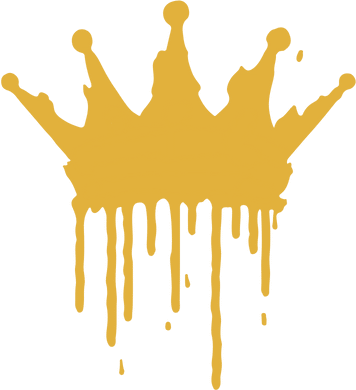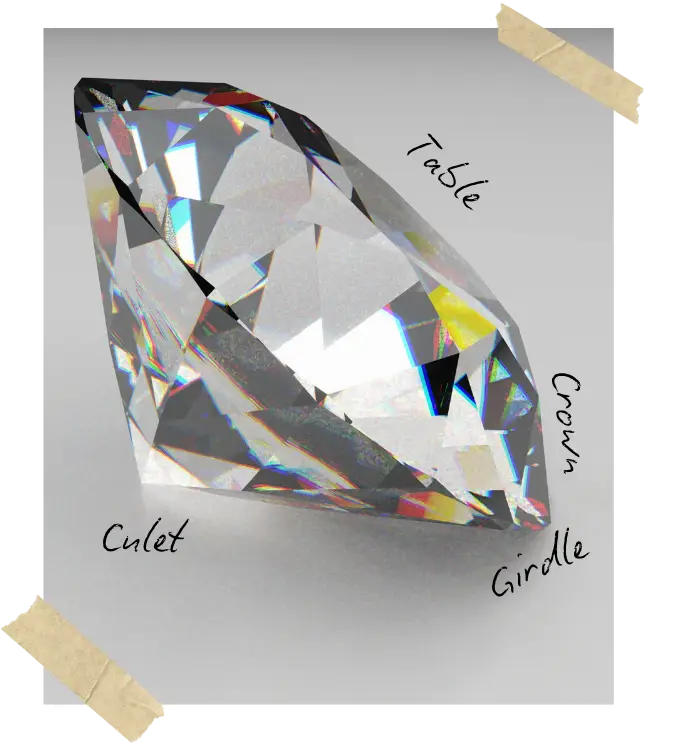A diamond’s cut refers to how well it has been shaped and faceted to interact with light. It isn’t about the shape – like round or oval – but rather the quality of the angles, proportions, and finish. A well-cut diamond reflects light in a way that maximises its brilliance, fire, and scintillation: so this is what to look out for.

The Anatomy Of A Diamond #
To appreciate the intricacies of a diamond’s cut, it helps to know its basic parts:
- Table: The flat top surface of the diamond.
- Crown: The upper portion above the girdle.
- Girdle: The widest part, forming the boundary between crown and pavilion.
- Pavilion: The lower part beneath the girdle.
- Culet: The tiny point at the very bottom (or sometimes, in the rarer cuts, a flat facet).
The angles and proportions between these facets determine how light interacts with the diamond – how it bounces the light around to create the most sparkle and brilliance.
How Diamond Cuts Are Graded #
There are a few different ways diamonds are graded, with scales that are tweaked between institutes (hello, GIA, IGI etc). These grading criteria evaluate:
- Proportions: The relationship between a diamond’s facets and angles, which affects how light is reflected and refracted.
- Symmetry: The precision of facet alignment. Symmetry ensures light interacts evenly across the diamond’s surface.
- Polish: The smoothness of the diamond’s surface, which directly influences its ability to reflect light.
Cut Grades #
You will often see diamond cut and diamond shape used interchangeably, but they are two very distinct meanings. Diamond cut refers to the quality whereas diamond shape refers to the pattern/arrangement of the diamond – for example, an emerald cut, a round brilliant, or a heart shaped.
The diamond’s cut holds the key to its brilliance. Cut grades are evaluated with meticulous precision, offering clarity to buyers and ensuring you know exactly what you’re getting – before you drop your money on it.
👍🏼 An “Excellent” cut is the pinnacle, it doesn’t get any better. These are the diamonds that dance with light, reflecting brilliance, fire, and scintillation at their finest. We don’t tend to work with diamonds that don’t have this grade.
👍🏼 A step below, “Very Good” cuts still impress, with subtle differences in polish or proportions that hardly dim their radiance. Essentially, to the untrained eye, a “Very Good” will give you just as much as an “Excellent”.
🫳🏼 The “Good” grade, while still appealing, may let a little light escape, softening the sparkle – we’d recommend you stay away from these.
👎🏻 Meanwhile, “Fair” cuts reveal more obvious imperfections in symmetry or polish, and “Poor” cut stones, unfortunately, lack the brilliance you’d expect from a diamond, appearing dull and lifeless. And with so many wonderful diamonds on the market, we’d recommend you don’t even consider these.
Let’s Talk Numbers #
The quality of a diamond’s cut impacts its price more than many realise. Two diamonds with identical clarity, color, and carat can differ significantly in cost: all because of the cut. Why?
A well-cut diamond delivers sparkle – what many would argue is a stone’s most captivating feature. It’s worth every penny to ensure your diamond doesn’t just sit pretty but shines brilliantly.
So, how do you find the right cut for you? We always prioritised quality – “Excellent” or “Very Good” grades are your safest bets and we will only work with ‘excellent’. And remember, the light test never lies: a well-cut diamond will dazzle under direct light, no matter what.
Want to learn more about the 4Cs or explore our range of lab-grown diamonds? See our rings or book a consultation with our diamond experts today.



